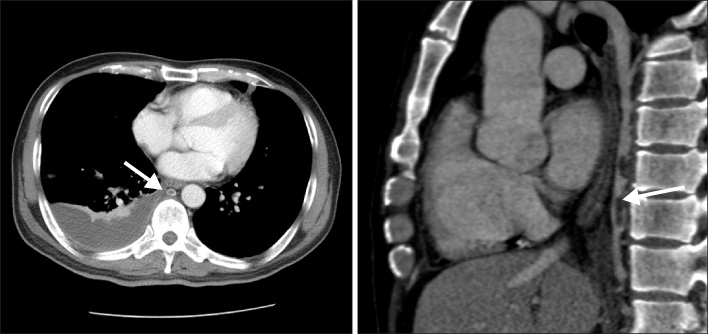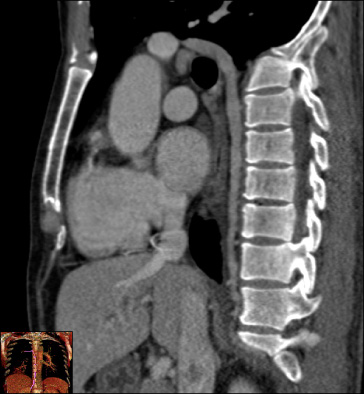Tuberc Respir Dis.
2012 Mar;72(3):328-331.
A Case of Septic Azygos Vein Embolism Caused by Staphylococcus aureus Bacteremia
- Affiliations
-
- 1Department of Internal Medicine, Myoungji Hospital, Kwandong University College of Medicine, Goyang, Korea. pulmochung@kd.ac.kr
- 2Department of Diagnostic Radiology, Myoungji Hospital, Kwandong University College of Medicine, Goyang, Korea.
Abstract
- A Septic embolism is a type of embolism infected with bacteria containing pus. These may become dangerous if dislodged from their original location. Embolisms of this type in the azygos vein are potentially fatal. The diagnosis of septic azygos vein embolism is difficult, so rapid diagnosis and treatment is important to avoid complications. Generally, treatment is enough for appropriate antibiotic therapy without anticoagulant therapy. We report a case of staphylococcal septic embolism in the azygos vein, which was discovered in a 51-year-old man exhibiting chest pain, dyspnea and fever. The patient was treated with antibiotic therapy alone without the use of anticoagulants.
Keyword
MeSH Terms
Figure
Reference
-
1. Ptaszynski AE, Hooten WM, Huntoon MA. The incidence of spontaneous epidural abscess in Olmsted County from 1990 through 2000: a rare cause of spinal pain. Pain Med. 2007. 8:338–343.2. Cook RJ, Ashton RW, Aughenbaugh GL, Ryu JH. Septic pulmonary embolism: presenting features and clinical course of 14 patients. Chest. 2005. 128:162–166.3. Ang AK, Brown OW. Septic deep vein thrombosis. J Vasc Surg. 1986. 4:563–566.4. Andes DR, Urban AW, Acher CW, Maki DG. Septic thrombosis of the basilic, axillary, and subclavian veins caused by a peripherally inserted central venous catheter. Am J Med. 1998. 105:446–450.5. Greenfield LJ, Proctor MC. Vena caval filter use in patients with sepsis: results in 175 patients. Arch Surg. 2003. 138:1245–1248.6. Meda MS, Lopez AJ, Guyot A. Candida inferior vena cava filter infection and septic thrombophlebitis. Br J Radiol. 2007. 80:e48–e49.7. Huang RM, Naidich DP, Lubat E, Schinella R, Garay SM, McCauley DI. Septic pulmonary emboli: CT-radiographic correlation. AJR Am J Roentgenol. 1989. 153:41–45.
- Full Text Links
- Actions
-
Cited
- CITED
-
- Close
- Share
- Similar articles
-
- Mechanical Thrombectomy for Septic Embolism Secondary to Staphylococcus lugdunensis Bacteremia without Infective Endocarditis: A Case Report
- Treatment Strategy for Staphylococcus aureus Bacteremia
- The risk factors and prognosis of methicillin-resistant staphylococcus aureus bacteremia: focus on nosocomial acquisition
- Hematogenous Septic Arthritis of the Hip in Extensive Burn
- Fatal Peripheral Septic Thrombophlebitis Complicated with Infective Endocarditis due to Methicillin-resistant Staphylococcus aureus: A Case Report with Autopsy Findings





